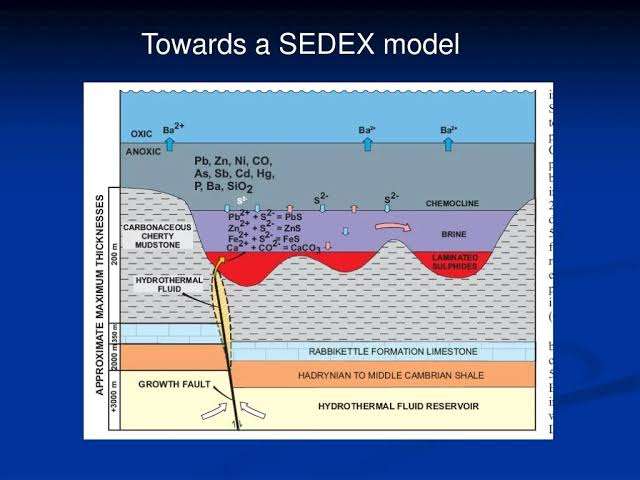Introduction:
Sedimentary Exhalative (SEDEX) deposits stand as intriguing geological formations, offering a glimpse into the subaqueous processes that shape the Earth’s crust. These deposits, characterized by the accumulation of minerals in marine sedimentary basins, play a significant role in the global mining industry. In this exploration, we delve into the nature, formation, and economic significance of SEDEX deposits.
Nature and Formation:
SEDEX deposits result from the interaction of seawater and hydrothermal fluids beneath the ocean floor. This process begins with the expulsion (exhalation) of metal-rich fluids from the Earth’s interior into a submarine setting. As these fluids mix with seawater, minerals precipitate out, forming layers of sulfide minerals. These layers accumulate over time, creating SEDEX deposits within sedimentary basins.
Ore Minerals and Mineralization:
The defining feature of SEDEX deposits is the prevalence of sulfide minerals. Lead, zinc, copper, and silver are commonly found in these deposits, with minerals such as galena (lead) and sphalerite (zinc) dominating. The mineralization process results in the formation of extensive, stratiform layers enriched in economically valuable metals.
Geochemical Signature:
Geochemical analyses play a crucial role in identifying SEDEX deposits. The unique signature of elevated concentrations of lead, zinc, and other associated metals helps geologists distinguish these deposits from other types. Understanding the geochemical characteristics guides exploration efforts, aiding in the discovery of potential SEDEX sites.
Key Features of SEDEX Deposits:
- Stratiform Nature: SEDEX deposits exhibit a stratified or layered structure, often resembling sedimentary rock formations.
- Association with Sedimentary Basins: These deposits are typically found within sedimentary basins on the ocean floor.
- Hydrothermal Exhalation: The mineralization process is initiated by the exhalation of hydrothermal fluids, creating an interaction zone with seawater.
Economic Significance:
SEDEX deposits are of paramount economic importance due to their rich metal content. Lead and zinc, in particular, are crucial for various industries, including construction, batteries, and manufacturing. The stratiform nature of SEDEX deposits often results in extensive ore bodies, making them attractive targets for mining operations seeking sustainable sources of these essential metals.
Notable Examples:
- Broken Hill Deposit (Australia): Renowned as one of the world’s richest lead-zinc-silver deposits, Broken Hill exemplifies the classic SEDEX-type deposit.
- Red Dog Mine (USA): Located in Alaska, Red Dog Mine is a significant producer of zinc and lead, showcasing the economic importance of SEDEX deposits.
- Famous Mines in Ireland: The Irish Midlands and other regions boast SEDEX deposits, contributing substantially to the country’s lead and zinc production.
Sedimentary Exhalative (SEDEX) deposits unravel the mysteries of mineralization beneath the ocean floor. Their stratiform nature, association with sedimentary basins, and economic significance make them essential subjects for geological exploration and mining endeavors. As we continue to probe the depths of Earth’s geological history, SEDEX deposits remain vital contributors to the global supply of lead, zinc, and other key metals, shaping the narrative of our planet’s dynamic evolution.
Formation Process of Sedimentary Exhalative (SEDEX) Deposits:

Sedimentary Exhalative (SEDEX) deposits, characterized by their stratiform layers of sulfide minerals in marine sedimentary basins, undergo a fascinating formation process shaped by submarine hydrothermal activity. The journey of SEDEX deposits from the Earth’s interior to the ocean floor involves several key stages:
1. Hydrothermal Exhalation:
The genesis of SEDEX deposits begins with hydrothermal exhalation—an expulsion of mineral-rich fluids from the Earth’s mantle into the ocean floor. These fluids, laden with metals such as lead, zinc, copper, and silver, vent into the marine environment. The source of these fluids is often associated with tectonic activity, where magma chambers release mineralized fluids through fractures in the Earth’s crust.
2. Interaction with Seawater:
As the metal-rich hydrothermal fluids rise through the oceanic crust, they encounter seawater. The interaction between these two components is a critical phase in SEDEX deposit formation. The seawater serves as a medium for the precipitation of minerals, particularly sulfides. The metals carried by the hydrothermal fluids react with sulfur in the seawater, resulting in the formation of sulfide minerals.
3. Layered Deposition:
The precipitated sulfide minerals settle on the ocean floor in a stratified or layered manner. Over time, these layers accumulate, forming extensive beds of sulfide-rich material. The stratiform nature of SEDEX deposits is a hallmark of their formation, reflecting the episodic release of hydrothermal fluids and the subsequent deposition of minerals.
4. Sedimentation and Consolidation:
Sedimentation processes further contribute to the growth of SEDEX deposits. Sediments, including organic matter and detrital material, may accumulate on top of the sulfide-rich layers. The weight of overlying sediments, combined with diagenesis (the physical and chemical changes during sediment consolidation), leads to the compaction and hardening of the mineralized layers.
5. Diagenetic Alterations:
Diagenetic processes play a role in the alteration of mineralogy within SEDEX deposits. Over time, the original sulfide minerals may undergo diagenetic changes, transforming into more stable mineral phases. This alteration can impact the economic viability of the deposit and influence the types of ore minerals present.
In summary, the formation process of SEDEX deposits is intricately linked to submarine hydrothermal activity, involving the exhalation of mineral-rich fluids, their interaction with seawater, layered deposition of sulfide minerals, sedimentation, and diagenetic alterations. The resulting stratiform deposits, with their wealth of economically valuable metals, continue to captivate geologists and drive exploration efforts in marine sedimentary basins around the world.
